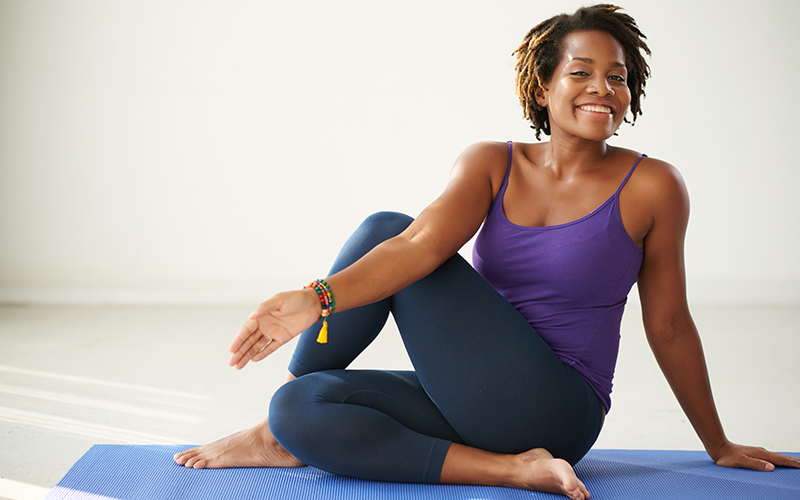
If you practice Yoga, or are thinking of beginning, you may be doing so because of a specific benefit. Perhaps it’s mindfulness, or maybe it’s the improved flexibility.
Regardless of why you chose to do Yoga, we wanted to highlight some of the many benefits that Yoga provides. But did you know that Yoga practice is actually a common area of academic study. So he have lost of scientific data to back up the benefit claims that you or others might be making.
In this article we will discuss some of the benefits that have strong scientific evidence.
What is Yoga
Origins
While it’s true that yoga has its roots in ancient meditative and philosophal practices of India, what we know as the practice of yoga as a form of exercise really begins in the 1920s in the US. It was at that time that yoga gurus thought to combine the postures of medieval Hatha Yoga (which had never been central) with contemporary gymnastic exercises.

In the decades that followed, the practice of modern postural Yoga (as opposed to the philosophical and meditative practice that preceded it) developed into the style we know today.
The modern yoga practice is defined primarily by maintaining a series of postures, or Asanas. In addition to the poses, Yoga practitioners also focus on their breath, controlling it to help deepen the impact of the Asanas and act as a form of meditation.
Major styles
Over the course of the 20th century, several different schools of yoga practice developed as the philosophies of various yogis diverged.

Iyengar Yoga – This yoga form is built around precision. The goal is to establish and hold correct alignments. This practice is known for the use of props and a progressive sequence to help practitioners get into the proper forms.
Bikram Yoga – Also known as hot yoga, the bikram style takes its practitioners through a specific set of 26 postures in a room that has been heated to 95-108℉. This style leads to more of a cardio workout than many other styles.
Sivananda Yoga – This style resembles the more classical yoga forms, in that it places higher importance on the spiritual/philosophical development. The physical poses, proper breathing, relaxation, diet, and meditation are all methods to enhance the practitioner’s path to spiritual enlightenment.
Ashtanga Yoga – The most typical style of yoga as exercise, this version is built around developing the strength and flexibility of the body through sequences of asanas (known as Vinyasas) and proper breathing.
There are many other schools and styles of modern postural yoga, but these four represent the most common areas of focus.
Concrete Benefits of Yoga
Now that we’ve seen a brief history of Yoga and understand the different types of yoga practice, let’s look at the proven health benefits.
Improved Flexibility and Balance
This benefit is the most apparent. Yoga, as a physical exercise, is focused on stretching the limbs and maintaining balance in a variety of poses. For someone engaged in a regular yoga practice, flexibility and overall balance, not just balance within a few specific poses, will improve.

What is interesting is that you actually begin to see these benefits after only a few sessions. This makes Yoga one of the more rewarding exercise programs for many folks, because they benefits become apparent right away, rather than over months of hard work.
The improvement of flexibility and balance also makes Yoga a great exercise program for the elderly or anyone suffering from a condition that impairs one’s balance.
Stress & Anxiety Relief
Many people claim that Yoga has a positive impact on the management of stress and anxiety. The notion here is that the breathing, postures, and focus on centering all help you manage your emotional response to the world.
While no one has yet conclusively proven how yoga does it, multiple scientific studies support these claims. In one study, women who engaged in a three month yoga program had significantly reduced cortisol levels (the stress hormone) than those who had not done regular yoga.
Another study focused on 64 women with PTSD, half of whom were assigned to a yoga practice in addition to their standard treatment. While both the control group and the yoga group saw reductions in their PTSD symptoms, the yoga group maintained their progress, while the control group saw a significant number of relapses.
Body Image Mindfulness
The practice of yoga typically requires an individual to focus on their forms and breathing in the moment. There are no mirrors, so a yoga student usually must focus inward, and take their cues from the way that their body feels. This practice usually teaches the student not just how to hold a pose, but to be more in touch with their body and what is happening in the moment.

Surveys of yoga practitioners find that they are more satisfied and less critical of their bodies than non-yoga students. The positive impact results from both the apparent positive changes that a regular yoga practice can impart, but also the greater acceptance of one’s own body.
Heart Health
As with many cardio exercise programs, the regular practice of Yoga has been shown to reduce blood pressure and resting heart rate, while also improving one’s cholesterol and triglyceride levels. All of these factors are indicators of heart health.
But as we’ve shown, Yoga also helps reduce stress and anxiety while promoting balance. These two factors amplify Yoga’s impact on improving cardiovascular health. Because of this, Yoga has been shown to slow or stop the progression of heart disease in patients.
Improved Posture & Back Function
Yoga helps to improve flexibility. A big part of the balance improvement of Yoga comes from the stronger core that Yoga helps to develop.
With a stronger core, you can more easily adopt a better, more upright posture. Greater flexibility will also relieve the muscle tightness and restriction that may be causing you pain or limiting your mobility.
Additionally, a stronger core and greater flexibility will relieve strain from your back. Likely decreasing pain, but most certainly providing a greater degree of movement.
What we see, when we examine yoga closely and scientifically, is that it provides real, concrete benefits. In many cases these benefits are unique to Yoga and are not provided by other sports or forms of exercise.

